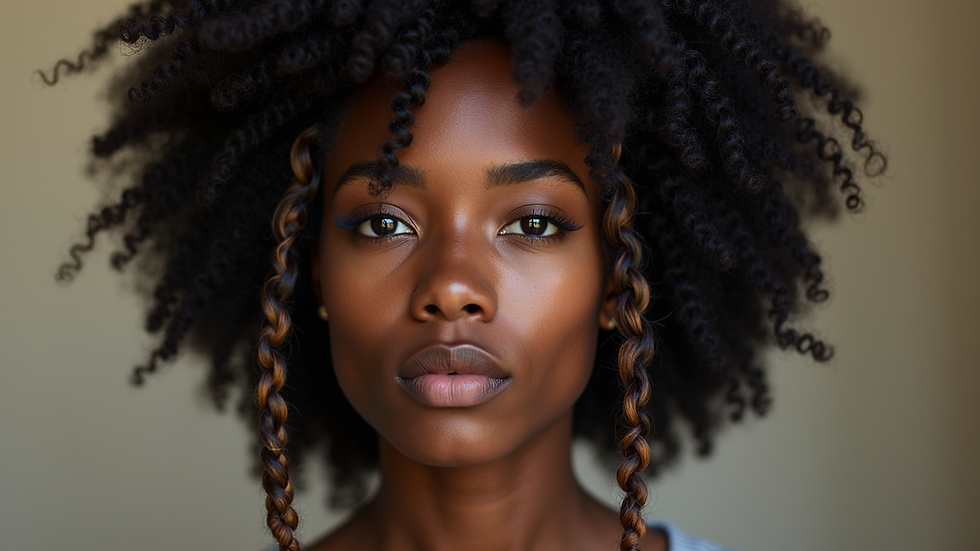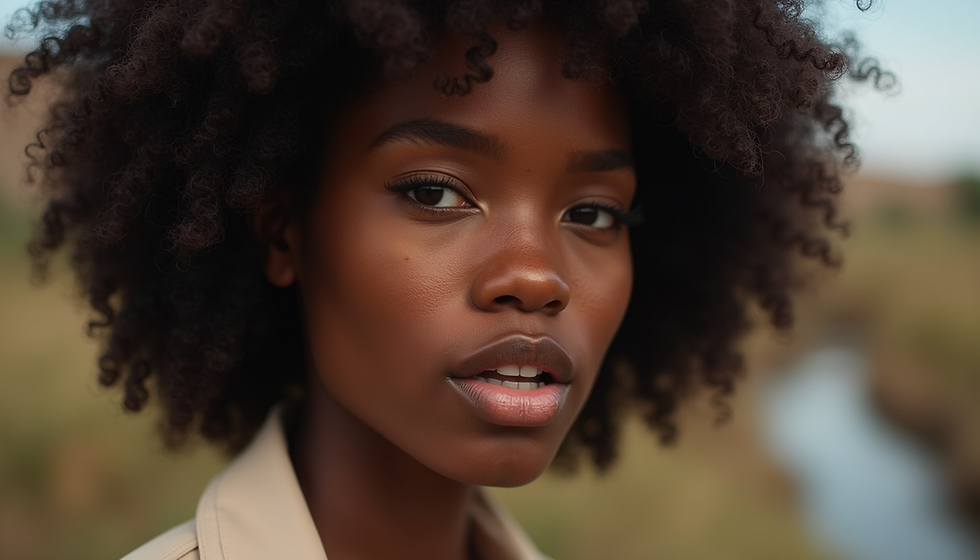Embracing Protective Hairstyles for Afro Hair
- Djimo Sandrine
- Oct 31
- 4 min read
Updated: 1 day ago
What Are Protective Hairstyles?
Protective hairstyles are styles that tuck away the ends of your hair, minimizing exposure to harsh elements and reducing manipulation. By limiting daily styling and friction, these hairstyles help prevent split ends, breakage, and dryness. Protective styles can last from a few days to several weeks, depending on the style and how well you maintain it.
These hairstyles are especially important for Afro hair because of its natural curl pattern and fragility. Afro hair tends to be drier and more prone to breakage, so protecting it with the right styles can make a big difference in hair health and length retention.
Benefits of Protective Hairstyles
Reduced breakage: By keeping hair ends tucked away, protective styles reduce friction and breakage.
Moisture retention: Styles that cover the ends help lock in moisture, preventing dryness.
Less daily manipulation: Protective styles reduce the need for daily combing or brushing, which can cause damage.
Hair growth support: Healthy hair that is well-protected is more likely to grow longer and stronger.
Versatility: Protective hairstyles come in many forms, allowing you to express your style while caring for your hair.
Popular Protective Hairstyles for Afro Hair
Box Braids
Box braids are individual plaits that are sectioned into square-shaped parts. They are low-maintenance and can last for several weeks. Box braids protect your hair by keeping it tucked away and reducing manipulation.
Twists
Twists involve dividing the hair into sections and twisting two strands around each other. They are gentle on the hair and can be styled in various ways, such as Senegalese twists or Marley twists.
Cornrows
Cornrows are braids that lie flat against the scalp, created by braiding the hair close to the head. They are great for keeping hair neat and protected, and can be styled in intricate patterns.
Wigs and Weaves
Wigs and weaves allow you to cover your natural hair completely, protecting it from environmental damage. When installed properly, they give your hair a break from heat and styling tools.
Bantu Knots
Bantu knots are small coiled buns created by twisting sections of hair and wrapping them into tight knots. They protect the ends and can also create beautiful curls when taken down.
How to Choose the Right Protective Hairstyle
Choosing the right protective hairstyle depends on your hair type, lifestyle, and personal preferences. Here are some factors to consider:
Hair length and texture: Some styles work better on longer hair, while others suit shorter hair.
Maintenance level: Consider how much time you want to spend on upkeep.
Scalp health: Avoid styles that pull too tightly and cause tension on the scalp.
Lifestyle: Choose styles that fit your daily activities and comfort.
Hair goals: If your goal is length retention, opt for styles that fully protect the ends.
Preparing Your Hair for Protective Styles
Before installing any protective hairstyle, it’s essential to prepare your hair properly:
Deep condition: Use a deep conditioner to restore moisture and strengthen your hair.
Detangle gently: Use a wide-tooth comb or fingers to remove knots without causing breakage.
Trim damaged ends: Cutting off split ends helps prevent further damage.
Cleanse your scalp: Wash your scalp thoroughly to remove buildup.
Moisturize: Apply leave-in conditioners or oils to keep hair hydrated.
Maintaining Protective Hairstyles
Maintaining your protective style is key to keeping your hair healthy:
Keep your scalp clean: Use a gentle cleanser or diluted shampoo to wash your scalp without disturbing the style.
Moisturize regularly: Use water-based sprays and light oils to keep hair hydrated.
Protect at night: Wrap your hair with a satin or silk scarf or use a satin pillowcase to reduce friction.
Avoid tight styles: Styles that pull too much can cause tension and hair loss.
Limit style duration: Keep protective styles in for no longer than 6-8 weeks to avoid matting and buildup.
Common Mistakes to Avoid
Neglecting scalp care: A healthy scalp is the foundation for healthy hair.
Leaving styles in too long: This can cause tangling and breakage.
Using heavy products: Thick creams and butters can cause buildup and weigh hair down.
Ignoring signs of damage: If your scalp feels sore or hair is falling out, remove the style and treat your hair.
Tips for Healthy Afro Hair Beyond Protective Styles
Nourishment for Your Hair
Eating a balanced diet is crucial. Nutrients like vitamins A, C, E, and biotin support hair health. Incorporate fruits, vegetables, and proteins into your meals. Staying hydrated is equally important. Drinking water helps keep hair and scalp hydrated.
Gentle Styling Practices
Limit heat styling. Excessive heat can damage fragile hair. Regular trims are essential, too. Keep ends healthy by trimming every 8-12 weeks. Use gentle tools. Avoid metal combs and brushes that can snag hair.
Embracing Your Natural Beauty
Protective hairstyles are a powerful tool to help maintain healthy Afro hair. By choosing the right style, preparing your hair properly, and maintaining it well, you can enjoy beautiful, strong hair that grows longer over time. Remember, your hair health is a journey, and protective styles are one of the best ways to support it.
Start exploring protective hairstyles today and give your Afro hair the care it deserves. Embrace your unique beauty and let your hair shine!



Comments